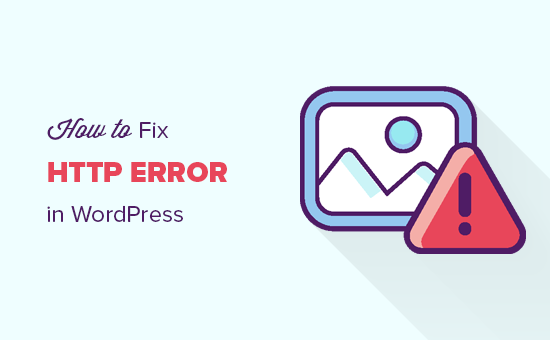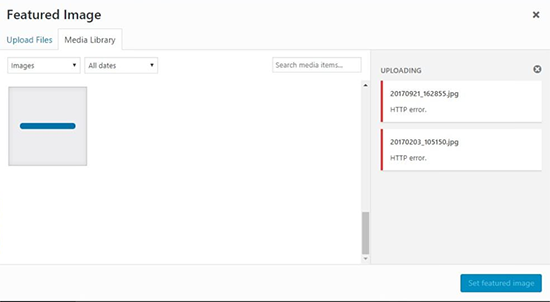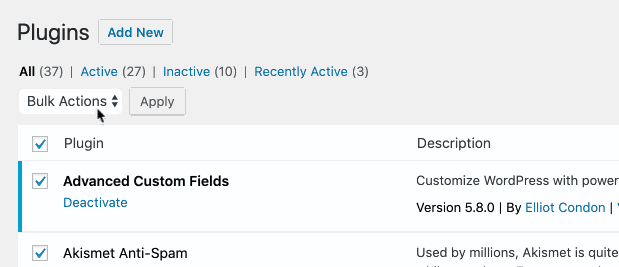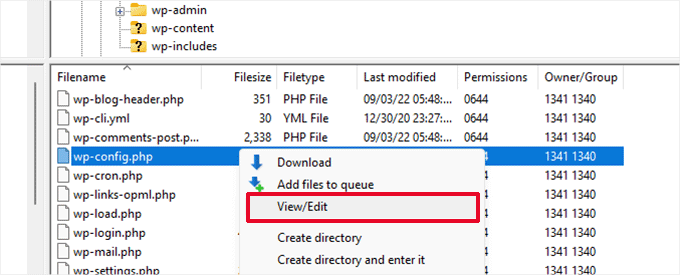Ogni giorno carichiamo molte immagini su WordPress come parte del nostro processo di creazione dei contenuti. Ma a volte ci imbattiamo in errori come l’errore di caricamento delle immagini HTTP.
Siamo certi che anche a voi sarà capitato e sappiamo quanto possa essere frustrante, soprattutto quando siete nel bel mezzo della creazione di contenuti. Può bloccare il vostro flusso di lavoro e lasciarvi con il dubbio di cosa sia andato storto.
In questa guida completa, vi mostreremo come risolvere facilmente i problemi di caricamento delle immagini in WordPress.

Cosa causa l’errore HTTP durante il caricamento dei file multimediali in WordPress?
Molte cose possono portare a un errore HTTP quando si cerca di caricare immagini sul proprio sito WordPress utilizzando il media uploader di WordPress.
In pratica, WordPress non è in grado di capire la causa ed è per questo che visualizza il messaggio generico “errore HTTP”.

L’aspetto frustrante di questo errore HTTP di caricamento di WordPress è che non fornisce alcun indizio su cosa possa averlo causato. Questo significa che dovrete provare diverse soluzioni per trovare la causa e risolvere l’errore.
Detto questo, vediamo come risolvere i problemi e l’errore HTTP durante il caricamento dei media in WordPress. Sentitevi liberi di usare i link sottostanti per passare a uno qualsiasi dei metodi per risolvere l’errore:
Non avete tempo di risolvere da soli i problemi di caricamento delle immagini? I Servizi Pro di WPBeginner possono aiutarvi! Con i nostri convenienti Servizi di assistenza WordPress di emergenza, potete assumere esperti per risolvere problemi di immagine, risolvere errori di plugin e temi, ottimizzare il database di WordPress e molto altro ancora. Programmate oggi stesso i Servizi di assistenza WordPress!
1. Provare a caricare nuovamente l’immagine
Per prima cosa, è necessario attendere qualche minuto e poi provare a caricare nuovamente il file immagine sul sito web WordPress. Questo errore è talvolta causato da un traffico insolito e da scarse risorse del server, che vengono corrette automaticamente sulla maggior parte degli host WordPress.
Se non funziona, si consiglia di provare uno o più dei seguenti metodi:
- Aggiornare il browser o cancellare la cache del browser.
- Ridimensionare e rinominare l’immagine di WordPress e caricarla nuovamente nella libreria multimediale. Verificate il nostro elenco di plugin per l’ottimizzazione delle immagini per ridurre le dimensioni dei file.
- Salvare il file in un formato diverso. Ad esempio, è possibile cambiare JPEG in PNG utilizzando un software di editing di immagini. Dopodiché, provare a caricare nuovamente il file.
Se seguendo tutti questi passaggi si ottiene ancora l’errore di caricamento delle immagini di WordPress, allora il problema non è causato da un inconveniente temporaneo e richiede sicuramente la vostra attenzione immediata.
2. Disattivare tutti i plugin e il tema attuale
Se avete installato di recente un nuovo plugin di WordPress, è possibile che sia incompatibile con gli altri plugin e che interrompa il processo di caricamento delle immagini. Per verificare se questo è il caso, è possibile disattivare tutti i plugin di WordPress.
Se l’errore HTTP scompare dopo aver disattivato un plugin di WordPress, allora potrebbe essere il colpevole dell’errore HTTP di caricamento dell’immagine. È possibile installare un plugin alternativo o contattare lo sviluppatore per ottenere assistenza.
Per ulteriori informazioni, consultate la nostra guida su come disattivare facilmente tutti i plugin di WordPress e su come disattivare i plugin quando la dashboard di WordPress è inaccessibile.

Allo stesso modo, a volte i conflitti tra temi possono disturbare il processo di uploader delle immagini. I temi possono includere funzionalità che possono interferire con il modo in cui WordPress gestisce l’uploader dei media.
Fortunatamente, identificare un conflitto di temi è relativamente semplice. È possibile passare temporaneamente a un tema predefinito di WordPress. Per ulteriori informazioni, selezionate la nostra guida su come cambiare correttamente i temi di WordPress.

Una volta attivato il tema predefinito, provare a caricare nuovamente un’immagine. Se l’errore scompare, è probabile che il problema riguardi il tema attuale. In questo caso, è possibile verificare se è disponibile un aggiornamento del tema. Spesso gli aggiornamenti correggono problemi di compatibilità e bug.
In alternativa, è possibile contattare lo sviluppatore del tema per ottenere assistenza. Potrebbe essere in grado di fornire una patch o di offrire indicazioni su come correggere il conflitto.
3. Aumentare il limite di memoria di PHP
WordPress è scritto nel linguaggio di programmazione PHP. Inoltre, la quantità di memoria allocata per i diversi processi PHP è determinata dal server di web hosting.
Se il caricamento delle immagini richiede una quantità di memoria PHP superiore a quella disponibile, è possibile che venga visualizzato l’errore HTTP di caricamento delle immagini in WordPress.
Per risolvere questo problema, è necessario aumentare la memoria che PHP può utilizzare sul server.
Per prima cosa è necessario accedere ai file del sito utilizzando un client FTP o l’applicazione File Manager nella dashboard del proprio hosting web. Quindi, andare nella directory principale e trovare il file wp-config.php.

Sarà quindi necessario modificare il file wp-config.php con un editor di testo e aggiungere la seguente riga di codice:
1 | define( 'WP_MEMORY_LIMIT', '256M' ); |
Questo codice aumenta il limite di memoria di WordPress a 256 MB, il che sarebbe sufficiente a risolvere qualsiasi problema di limite di memoria.
Infine, è necessario salvare e caricare il file sul server.
Per saperne di più, consultate la nostra guida passo passo su come aumentare il limite di memoria PHP in WordPress.
4. Modificare la libreria dell’editor di immagini da Imagick a GD Library
WordPress si basa su PHP, che utilizza due moduli per gestire le immagini. Questi moduli si chiamano GD Library e Imagick. WordPress può utilizzare uno dei due, a seconda di quale sia disponibile.
Tuttavia, Imagick ha spesso problemi di memoria che causano l’errore HTTP durante il caricamento delle immagini. Per risolvere il problema, è possibile rendere GD Library l’editor di immagini predefinito.
È possibile farlo semplicemente aggiungendo questo codice al file functions.php del proprio tema WordPress o utilizzando WPCode (consigliato):
1 2 3 4 5 6 7 | function wpb_image_editor_default_to_gd( $editors ) { $gd_editor = 'WP_Image_Editor_GD'; $editors = array_diff( $editors, array( $gd_editor ) ); array_unshift( $editors, $gd_editor ); return $editors;}add_filter( 'wp_image_editors', 'wpb_image_editor_default_to_gd' ); |
Per maggiori dettagli, potete consultare la nostra guida su come aggiungere codice personalizzato in WordPress.
Dopo aver aggiunto questo codice, è possibile riprovare a caricare i file utilizzando il caricatore multimediale. Se questo non risolve il problema, è possibile rimuovere il codice e provare altri metodi descritti in questo articolo.
5. Limitare le immagini modificando .htaccess
Questo metodo consente di controllare il modo in cui Imagick utilizza le risorse del server. Molti provider di hosting condiviso limitano la capacità di Imagick di utilizzare più thread per velocizzare l’elaborazione delle immagini. Tuttavia, questo comporta la visualizzazione di un errore HTTP durante il caricamento delle immagini.
Una soluzione semplice consiste nell’aggiungere il seguente codice nel file .htaccess:
1 | SetEnv MAGICK_THREAD_LIMIT 1 |
Questo codice limita semplicemente Imagick a utilizzare un singolo thread per elaborare le immagini.
6. Aggiornare la versione di PHP
Se il vostro sito WordPress utilizza una versione obsoleta di PHP, potrebbe causare l’errore di caricamento delle immagini HTTP. Questo perché le nuove versioni di PHP hanno migliorato le prestazioni e in genere utilizzano meno memoria.
Fortunatamente, è facile verificare la versione di PHP e aggiornarla. Per maggiori dettagli, consultate la nostra guida per principianti su come aggiornare la versione di PHP in WordPress.
7. Verifica delle autorizzazioni di file e cartelle
Per funzionare correttamente, WordPress si basa su autorizzazioni specifiche per file e cartelle. Autorizzazioni errate possono impedire a WordPress di accedere o modificare i file, causando errori di caricamento.
Ad esempio, se la directory di uploader non dispone di autorizzazioni di scrittura adeguate, WordPress non sarà in grado di salvare le immagini caricate.
Per garantire la correttezza dei permessi dei file, consultate la nostra guida su come risolvere l’errore dei permessi di file e cartelle in WordPress.
8. Abilitare la modalità Debug
A volte, gli errori PHP sottostanti possono manifestarsi come errore di caricamento dell’immagine HTTP, rendendo difficile la risoluzione dei problemi.
Abilitando la modalità di debug nella configurazione di WordPress, ogni errore PHP verrà rivelato nel registro di debug, fornendo preziosi indizi sulla causa principale del problema di uploader.
Per le istruzioni su come abilitare la modalità WP_DEBUG, fate riferimento al nostro articolo su come abilitare la modalità di debug di WordPress. Questa guida fornisce istruzioni passo-passo sull’aggiunta del codice necessario al file wp-config.php.
9. Verifica delle risorse dell’ospitato
Se il sito web raggiunge la quota di memoria o incontra limitazioni nelle risorse del server, potrebbero verificarsi errori di caricamento. Ad esempio, uno spazio su disco insufficiente può impedire a WordPress di creare nuovi file o cartelle necessari per l’uploader delle immagini.
La maggior parte dei provider di hosting web offre un pannello di controllo dove è possibile visualizzare l’utilizzo delle risorse del proprio sito web, compreso lo spazio su disco. Se non riuscite a visualizzarlo, contattate il team di assistenza del vostro provider di hosting per ricevere assistenza.
Se vi state avvicinando al limite di spazio di archiviazione, valutate la possibilità di ottimizzare le risorse. Ad esempio, i file immagine di grandi dimensioni possono consumare molto spazio. È possibile ottimizzare le immagini per ridurre le dimensioni dei file prima di caricarle.
Se l’ottimizzazione delle risorse non è sufficiente, considerate la possibilità di passare a un piano di host con più spazio di archiviazione. Questo fornirà la capacità aggiuntiva necessaria per i file del vostro sito web.
Se siete alla ricerca di un fornitore di hosting WordPress affidabile con un generoso spazio di archiviazione, Bluehost è un’opzione popolare. Offre diversi piani per soddisfare le esigenze di diversi siti web.

Speriamo che questo articolo vi abbia aiutato a risolvere l’errore di caricamento delle immagini HTTP in WordPress. Potreste anche voler consultare il nostro elenco definitivo degli errori più comuni di WordPress e di come risolverli, e i problemi più comuni dell’editor di blocchi.
Se questo articolo vi è piaciuto, iscrivetevi al nostro canale YouTube per le esercitazioni video su WordPress. Potete trovarci anche su Twitter e Facebook.





John
not worked with any method
WPBeginner Support
If none of the methods in this article worked, you may want to reach out to your hosting provider to try the general troubleshooting steps in our article: https://www.wpbeginner.com/beginners-guide/beginners-guide-to-troubleshooting-wordpress-errors-step-by-step/
Admin
Sandy
I tried Option 3. Now my entire home page is blank. Individual pages are still there. The Sidebar is still visible, but the rest of the home page is blank.
Please help if possible.
Thank you,
Sandy
WPBeginner Support
You may want to ensure you didn’t change your homepage settings while troubleshooting and have you removed the code to see if that solved the missing content?
Admin
Sanju
Worked like charm Option 3.
While My wordpress admin panel is slow.. Working on it. Any guide?
WPBeginner Support
You may want to try disabling your plugins to see if one of your plugins could be slowing the admin area.
Admin
Lucas Vidal
Method #3 worked like a charm
WPBeginner Support
Glad our guide could help
Admin
Mounika
Thank a lot ! 3rd option worked for me.
WPBeginner Support
Glad our article could help
Admin
Rahana Razak
Thank you sir, its working (3rd one worked for me)
WPBeginner Support
Glad our article could help
Admin
Adriana
Hello,
I have tried all of them steps, and none has worked, I am not sure what else to do at this point , as i’m on limited time and would need this fixed , if any other ideas please do help. Thank you so much
WPBeginner Support
You may want to reach out to your hosting provider to see if they see any errors on their end that could be causing the issue.
Admin
Karan
Thanks. It works by changing the default image file library.
WPBeginner Support
Glad our article could help solve the issue
Admin
SL101
thank you so much, 3rd solution did the trick.
WPBeginner Support
Glad our article could help
Admin
DrewDownz
Number 3! Pow! Now lets hope in shows up in other browsers!
WPBeginner Support
Glad our article could help
Admin
Salbin Sajan
Hello brother… Thanks for your article ..
#3 Solved the issue ..
Thanks again ..
WPBeginner Support
Glad our tutorial could help
Admin
Tina
Hi,
thanks for this guide. Unfortunately, all these ideas did not work for me. Today, in an attempt to remove the “website is on partially safe” SSL certificate message, I used “Search and Replace” plugin to search my databases for “http” and changed those to “https”. That’s the only thing I could relate to this error, but since I am no expert on this, I don’t know how and if I can fix this or how I can undo these changes. Any help?
WPBeginner Support
For your site having mixed content you would want to take a look at our SSL issues article rather than this one: https://www.wpbeginner.com/wp-tutorials/how-to-fix-common-ssl-issues-in-wordpress-beginners-guide/
Admin
kyle
Hi i get the http error everytime i upload an image over 4mbs. I have contacted my web designer and host and they have both tried to load images over 15mbs and it is working for them. However, i have tried mulitple computers on different internet connections and i still get the http error. Can u please help?
WPBeginner Support
If none of the methods in this article resolve the issue you may want to try creating a new user to see if it is due to an issue with your user or the general troubleshooting steps in: https://www.wpbeginner.com/beginners-guide/beginners-guide-to-troubleshooting-wordpress-errors-step-by-step/
Admin
Hien
I just wanted to comment, #3 definitely helped with 503 error/http error when uploading pictures sometime. Other time, upload pictures fine.
WPBeginner Support
Thanks for sharing and glad our article could help resolve the issue
Admin
rahul sharma
Sir in the function.php where should i put the code??? {in the end or In the middle}
WPBeginner Support
You would normally want to put added code at the end in case you need to edit or remove the code later
Admin
Cindy
Thank you so much! The third option worked for me!
WPBeginner Support
Glad our guide could help
Admin
Mike Gaudreau
In my case, I simply logged out of the dashboard and right back in and the problem was cleared.
WPBeginner Support
Thanks for sharing that, it sounds like either your caching had a hiccup or you ran into one of the server issues
Admin
Mohamed
You can’t imagine the level stress of this HTTP thing has created on me. Number 3 is my lifesaver. Thank you for posting this.
WPBeginner Support
Glad our article could help
Admin
OA
Thanks! Option 3 work for me.
WPBeginner Support
Glad our recommendation worked
Admin
Mohamed
Thanks…Method 3 did it well
WPBeginner Support
Glad our article could help
Admin
Janet
I had about 10 pictures to upload and repeatedly got the HTTP error for 3 of them. I finally sussed that those three had an apostrophe in the file name!!! Doh! Removing the apostrophe was the solution.
WPBeginner Support
Thanks for sharing your solution, glad you were able to get the files uploaded
Admin
Hector
Thanks, Number 3 did the trick. Awesome tutorial.
Rae
No. 3 worked for me too. Thank you for this!
WPBeginner Support
Glad our article could help
Admin
Sandra
Thanks for this! Number 3 fixed my problem
William Davidson
#2 worked for me. Easy peasy. Thanks for helping me fix it.
WPBeginner Support
Hey William,
Glad you found it helpful. Don’t forget to join us on Twitter for more WordPress tips and tutorials.
Admin
Magloire
This issue really stressed me up. No 3 solved my problem.
Thanks
Yann
3 worked for me too. I copied right at the end of function.php in Appearance > editor of WordPress
Eylene
Hi there,
Option 3 is working for me! Thank you so much this was driving me insane!!!
Alissa
Before I tried any of these solutions. I tried logging out of WordPress and logging back in, and suddenly I stopped getting the error message. So, you might want to try that first.
Isla S
I’ve noticed that this keeps happening to me with files that contain apostrophes in the filename. When I remove it, they upload fine
Perhaps try to remove the ‘ ?
Wanda
THANK YOU! Removing the ‘ worked for me
Andy
Thank you! This was driving me crazy, had been trying to solve this for a friend for days
Marek
No. 3 works, thanks.
Christina
None of these worked for me. After some more researching, I found that putting this bit of code at the bottom of the .htaccess worked for me:
# Exclude the file upload and WP CRON scripts from authentication
Satisfy Any
Order allow,deny
Allow from all
Deny from none
Don’t forget to back up your .htaccess file first just in case!
Savi Huang
None worked. Pls help!
NICOLE
Number 4 worked for me!!! Thanks so much!
Pat Smithers
No. 3 worked a charm.
Thank you so much!
mike
Please can will this solutions work on a localhost installation of wordpress?
WPBeginner Support
These methods should work with localhost, the memory limit may need to be modified using the program for your server such as MAMP or WAMP
Admin
Omar Ajruli
Option number three fixed my problem guys, thank you. Have a great day.
3. Change Image Editor Library Used by WordPress.
Ali HyDer
Its Working for me! Yuppiiiiiiiiiiiiiiiiii
Thanks Syed Balkhi
Emmanuel Usen Jackson
My blog shows me “An error occurred in the upload. Please try again later.”. Please what should I do?
Jake
Try again later
John
Tried all to no avail UNTIL i added the code to the functions.php file. A BIG thank you!
Dan
Adding that line to my .htaccess file did the trick! Thanks!
vishwas
i did all the above changes in my site still image is not uploading, please help me to resolve this issue (http error)
Casey
THANK YOU! Changing the image editor worked for me.
David
For me, the issue was a series of pictures with an apostrophe in the title. Renamed and it worked fine.
Tom Jaggard
I need help resolving the HTTP error when uploading large files. Someone else created my site with an upload size limit of 64Mb. I am trying to upload audio files that are sometimes larger than 64Mb. I added a plug-in (Upload Max File Size) to change my max upload size to 128Mb. I changed memory_limit in PHP.ini to 256M. I change max_execution_time in PHP.ini to 300. I set memory_limit in wp-config to 256M. I changed memory_limit in .htaccess to 256M. I tried adding the code to .htaccess to force it to use the GD Library instead of Imagick. It didn’t work, so I remove that code and then added the line to limit Imagick to 1 thread. In spite of all of these changes, I still get the HTTP error when loading a file larger than 64Mb.
Any more ideas?
Thanks!
siddharth pathak
thanks a lot, I was trying to fix this from last 2 hour and after reading this article did it in just few sec and already tested thanks a lot
Mauricio Lazo
As a side note, another thing that can be giving you HTTP errors while uploading images is a configuration in you php.ini file, specifically the line “max_execution_time=30;”.
Some shared hosting providers limit PHP execution to a single core of the server, increasing the time it takes for PHP Imagick to get the image, process it and create thumbnails. So the suggestion is to increase max_execution_time to 120 seconds instead of the default 30 seconds.
wassim jied
Hello
In my case
function wpb_image_editor_default_to_gd( $editors ) {
$gd_editor = ‘WP_Image_Editor_GD’;
$editors = array_diff( $editors, array( $gd_editor ) );
array_unshift( $editors, $gd_editor );
return $editors;
}
add_filter( ‘wp_image_editors’, ‘wpb_image_editor_default_to_gd’ );
worked fine thanks
Php Memory limit 128Mo v 7.13 apache 2.4
Joost Walter
One of the causes of an upload error is the fact that there is an apostrophe in the name of the file that you try to upload. For instance a picture called ‘Let’s_dance.jpg’ will give an error, while ‘Lets_dance.jpg’ can be uploaded without any problems.
Floz
This was the problem in my case, thank you so much!! Saved me a lot of hassle ^_^